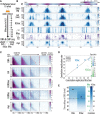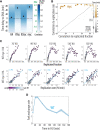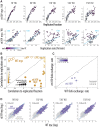Rtt109 promotes nucleosome replacement ahead of the replication fork
- PMID: 35609993
- PMCID: PMC9248883
- DOI: 10.1101/gr.276674.122
Rtt109 promotes nucleosome replacement ahead of the replication fork
Abstract
DNA replication perturbs chromatin by triggering the eviction, replacement, and incorporation of nucleosomes. How this dynamic is orchestrated in time and space is poorly understood. Here, we apply a genetically encoded sensor for histone exchange to follow the time-resolved histone H3 exchange profile in budding yeast cells undergoing slow synchronous replication in nucleotide-limiting conditions. We find that new histones are incorporated not only behind, but also ahead of the replication fork. We provide evidence that Rtt109, the S-phase-induced acetyltransferase, stabilizes nucleosomes behind the fork but promotes H3 replacement ahead of the fork. Increased replacement ahead of the fork is independent of the primary Rtt109 acetylation target H3K56 and rather results from Vps75-dependent Rtt109 activity toward the H3 N terminus. Our results suggest that, at least under nucleotide-limiting conditions, selective incorporation of differentially modified H3s behind and ahead of the replication fork results in opposing effects on histone exchange, likely reflecting the distinct challenges for genome stability at these different regions.
© 2022 Jonas et al.; Published by Cold Spring Harbor Laboratory Press.
Figures




References
Publication types
MeSH terms
Substances
LinkOut - more resources
Full Text Sources
Molecular Biology Databases
